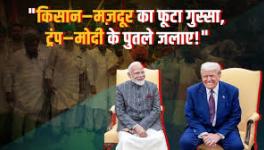REPLUG: May Day: A Peoples’ History

There is no other public holiday in India that accounts for such international relevance and national irrelevance. 1st May is celebrated globally as the international labour day. India, too, has declared it a public holiday wherein the workers are entitled to a paid holiday, but, ironically, only at the employer’s discretion!
It is not that May Day is celebrated with any less fanfare by the Indian working classes, yet it remains nationally irrelevant because only seven per cent of the organised working class with trade union membership partake in its celebrations by taking a day off. Whilst the rest ninety-three per cent of the working class in the ‘informal sector’ continue with daily jobs without a clue of history, the relevance of this day for the toiling masses of the world and how the history of the international labour struggles is written with blood-soaked bayonets and the indomitable resistance of the working class.
Not many are aware that the origins of May Day go back to antiquity. Between 28th April and 2nd May, the Romans honoured Flora, the Goddess of Flowers, and from the Middle Ages to the nineteenth century, people garlanded a maypole on 1st May. Celebrations were marked by music and dancing in the village greens. In 1717, a vast maypole was bought by Isaac Newton to support his 124-foot-long telescope!
The first political usage of maypoles was during the French Revolution of 1789, wherein it served as the Tree of Liberty, symbolising the Declaration of the Rights of Man.
It was only during the post-Civil War period in the United States of America that 1st May came to be directly associated with the working class. After the Civil War, labour had not organised itself in a manner the propertied classes had done. Notwithstanding organisational weaknesses, the drudgery of long working hours and the spread of anarchistic and communistic ideas allowed labour to develop class consciousness.
In 1884, the American Federation of Labour met under the leadership of Samuel Gompers (later chairman of the first convention of the International Labour Organisation), passing a historic resolution. It read, “Resolved, that eight hours shall constitute a legal day’s labour, from and after 1st May 1886, and that we recommend to labour organisations that they so direct their laws”.
Exactly two decades ago, Karl Marx spoke at the inaugural session of the International Workingmen’s Association, laying stress on the need to reduce the daily working hours. Congratulating the English working class on carrying the ten-hour working day bill, Marx said, “This struggle about the legal restriction of the hours of labour raged more fiercely since, apart from frightening avarice, it told indeed upon the great contest between the blind role of the supply and demand laws which form the political economy of the middle class, and social production controlled by social foresight, which forms the political economy of the working class.” Hence the Ten Hours Bill was not only a great practical success; it was the victory of a principle; it was for the first time that, in broad daylight, the political economy of the middle class succumbed to the political economy of the working class.”
On 1st May 1886, radical pamphlets appeared in America. One of the pamphlets famously declared, “Arouse ye toilers of America! Lay down your tools…one day of revolt, not of rest…a day not ordained by the bragging spokesmen of institutions holding the world of labour in bondage…a day on which to enjoy eight hours of work, eight hours for rest, eight hours for what we will”.
The pamphlet rejected any institutional mediation by the state and singularly stressed the working classes’ ability for self-emancipation.
The day was marked by labour demonstrations all over America, along with a massive wave of strikes. Tragedy struck on 3rd May when the striking workers at the McCormack Harvester plant in Chicago were attacked. As a response, a meeting was called at the Haymarket Square on 4th May. The notorious police attacked the congregation. Suddenly a bomb flew through the crowd killing one policeman and injuring seventy.
The trial of the labour leaders began on 21st June, and seven labour leaders were sentenced to death and scheduled to be hanged on 11th November 1887. After an intense campaign by the working classes all around the US and Europe, two leaders’ death sentences were commuted to life sentences, and the rest were hanged.
In a resolution passed by the socialist Second International’s meeting in Paris 1890, 1st May was declared as the day when labour was required to down their tools and demonstrate for an eight-hour workday.
It was the Bolshevik government that took power in Russia in 1917 which first declared May Day as a significant national holiday. The irony of history could not be starker because the second government to follow suit was Hitler’s Germany. May Day was declared the ‘National Day of Labour’, thereby robbing the ‘international’ content of the glorious struggle.
It is not a widely known fact that the Indian working class during the colonial period demanded an eight-hour workday two decades before the Chicago crackdown. The first strike of the Indian industrial workers occurred in the newly opened railways. In April-May 1862, 1200, labourers of Howrah Railway Station took part in this strike demanding an eight-hour workday. Keeping in mind that the Railways in India were first introduced only in 1853, this strike of a section of the Railway workers within 8 or 9 years of the beginning of the industry cannot but evoke great admiration.
Later on, it was only after the spread and consolidation of communistic, socialist ideas and the rise of the trade union movement in the 1920s that May Day became an important event in India. In 1927 1st May was celebrated for the first time in an organised manner in Bombay as Labour Day symbolising the opening of a new era of the Indian labour movement in conjunction with the international labour movement.
According to another version of history, May Day was first celebrated in 1923 in Chennai (then Madras) under the Presidentship of Singaravelu Chettiar, one of the founding members of the Communist Party of India. It is said that in the absence of a red flag in Comrade Chettiar’s house, he prepared one by tearing off one of his daughter’s red saree and hoisting it atop his house.
The following year, the communists in Calcutta operating under the Worker’s and Peasant’s Party (WPP) organised a massive rally against the Royal Commission on Labour on May Day. The Bombay working classes, now organised, also showed immense anti-imperialist zeal during the protest demonstrations against the Simon Commission (1928). The successes of the strikes and demonstrations against the arrival of the Simon Commission shocked the Congress and the reformist trade union leadership.
To conclude, May Day represents the internationalist moorings of the global working class like no other day on the Gregorian calendar—or any other calendar for that matter. It is worth quoting Eric Hobsbawm here. He wrote, “What is more, it is an occasion established not by the power of governments or conquerors, but by an entirely unofficial movement of poor men and women.”
The author is an independent research scholar. The views are personal.
(This article was published in 2022)
Get the latest reports & analysis with people's perspective on Protests, movements & deep analytical videos, discussions of the current affairs in your Telegram app. Subscribe to NewsClick's Telegram channel & get Real-Time updates on stories, as they get published on our website.
























